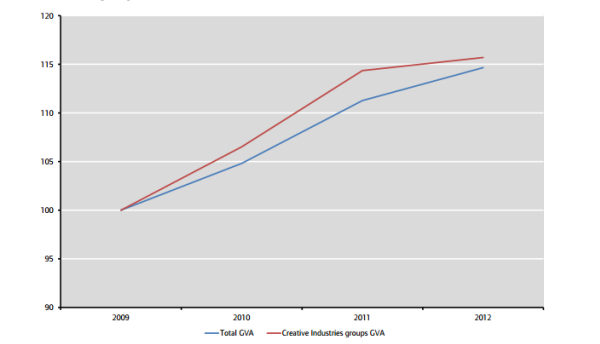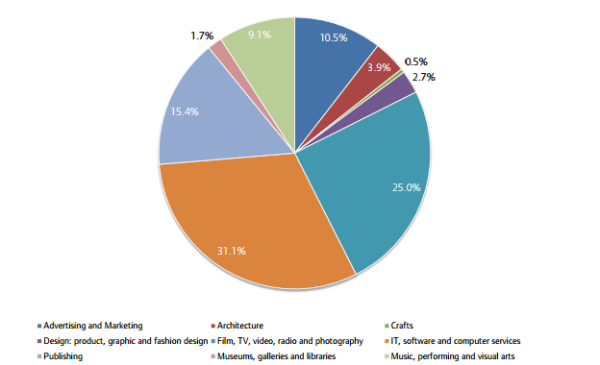Art World
London’s Creative Industries Booming, Just Not for Artists
Hourly wages are higher...for some.

Photo: via GLA Economics, "The Creative Industries in London"
Hourly wages are higher...for some.

Alyssa Buffenstein

London has long been a worldwide arts capital. As it goes, many artists are finding it a financially inaccessible place to live and work. But according to Greater London Authority Economics (GLA Economics)’s new study, The Creative Industries in London, creative workers in London actually have a higher median hourly wage than those in non-creative fields.
Analyzing the Gross Value Added (GVA) by creative jobs and jobs in creative fields to the city’s economy between 2008 and 2014, researchers found that “in London the median hourly pay in the creative economy in 2014 was £18.80, which compares to a median hourly pay of £15.26 in London’s ‘non-creative’ economy.”

“Changes in GVA for the London’s economy as a whole and for the creative industries groups in London, indexed to 2009=100.”
Photo: via GLA Economics, The Creative Industries in London.
A higher median, however, says little about the average creative worker’s wage. A few extremely high-earning creative professionals can skew the median upwards, while hordes of workers might still struggle to make their rent payments.
These findings come among talk of London rapidly becoming too expensive for artists, especially in central London, where, according to the GLA report, most creative jobs are concentrated.
A recent article by Anny Shaw in the Art Newspaper details how residential redevelopment and gentrification are contributing to rising rents in the British capital, pricing many artists out of the city. “Widespread residential development is not only pushing up living costs, but also creating a shortage of affordable artists’ studios,” writes Shaw. “Up to 30% of artists’ studios in London are at risk of disappearing in the next five years.”

“Contribution of each creative industries group to the total GVA of the creative industries in London, 2012”, according to GLA Economics calculations.
Photo: via GLA Economics, The Creative Industries in London.
“Music, performing, and visual arts” accounted for only 9.1% of GVA in 2012. The largest contributors to the economy that year were “IT, software, and computer services” at 31.1%, and “advertising and marketing” at 25% of GVA. The smallest were “crafts” at 0.5% and “museums, galleries, and libraries” at a measly 1.7%.
The total gross value added by all creative industries in London in 2012 was £34,601 million, a 16.4% increase since 2009. The London economy as a whole increased by 15.4% in the same period.
The point is? London’s creative industries are doing relatively fine. But it’s not working out so well for artists.
It’s an old and pervasive problem—supposedly only 1,654 fine artists make a living through fine art in New York City. A 2014 study found that artists aren’t being paid, and even in the supposed creative havens Berlin and L.A., artists fear getting priced out.
What can be done?